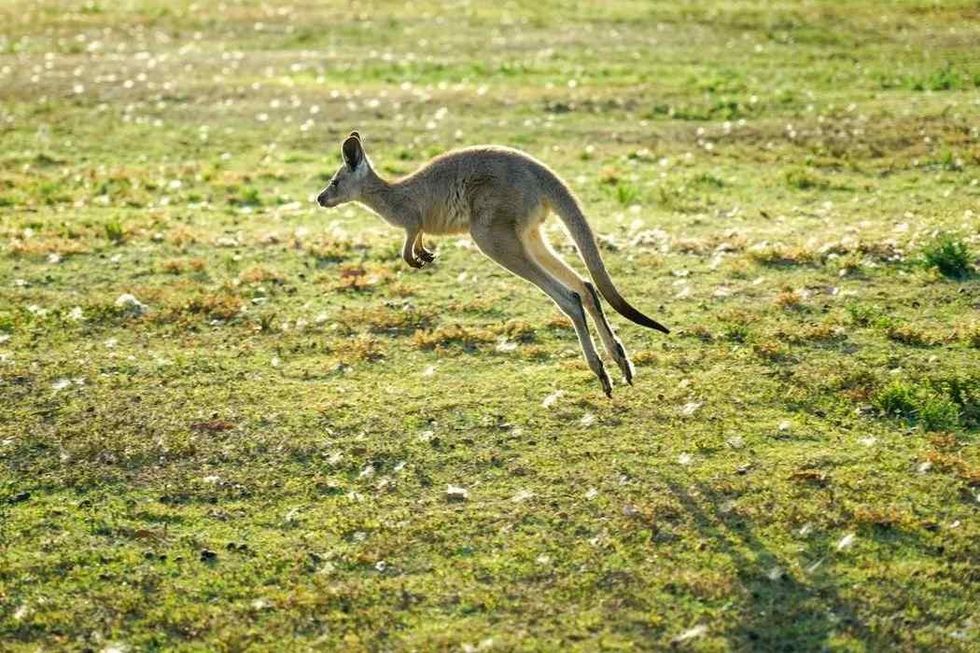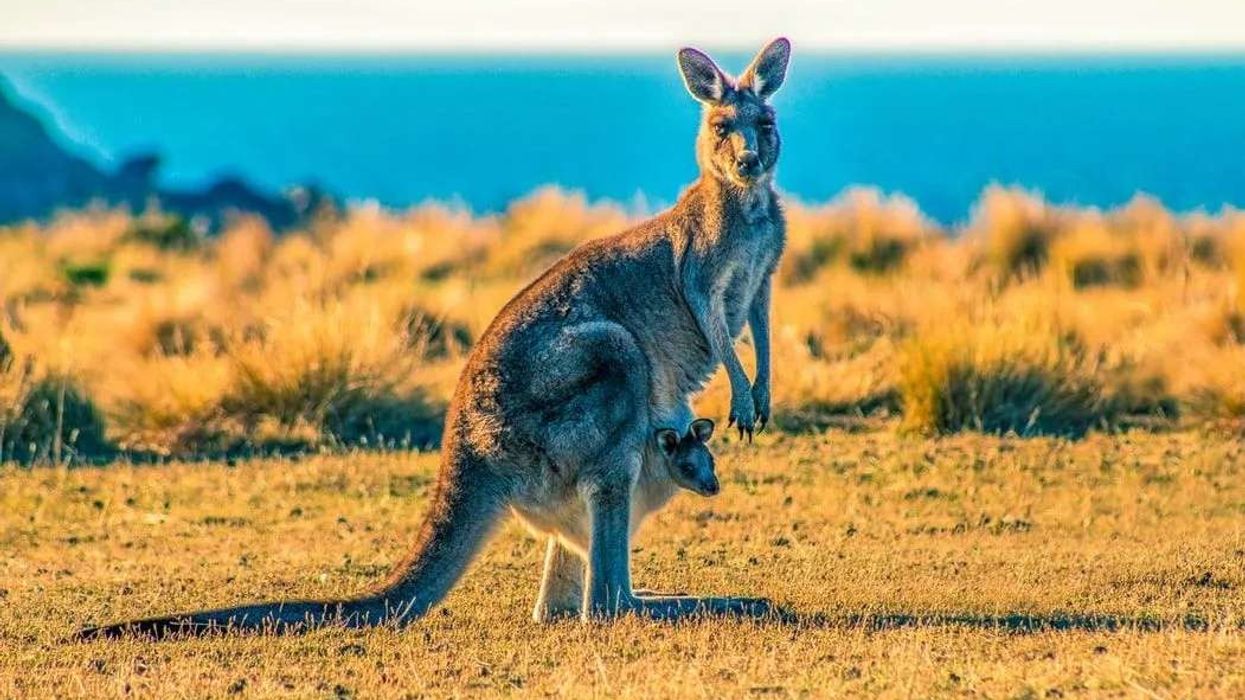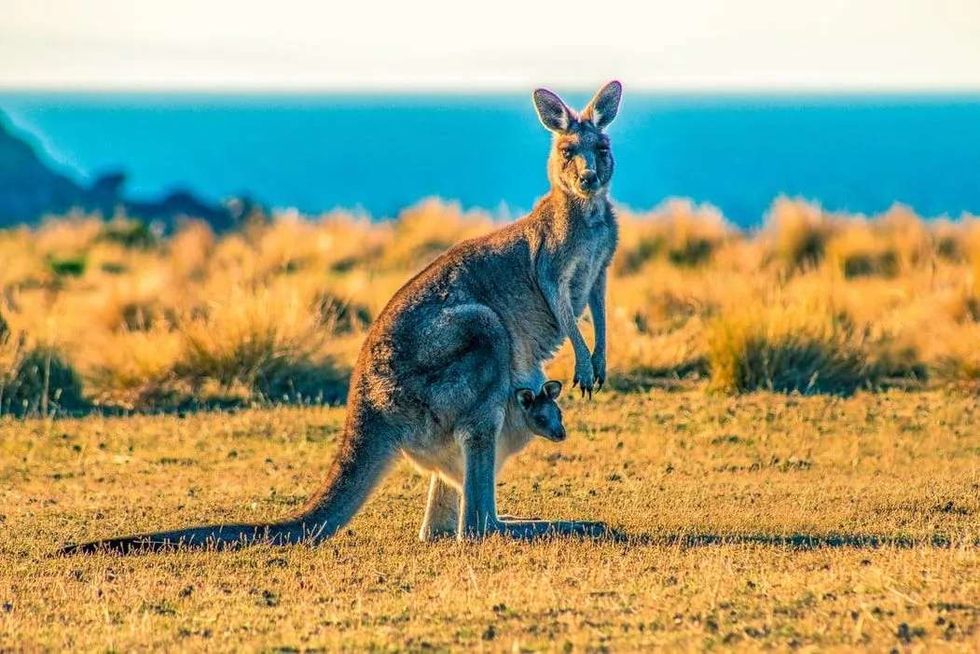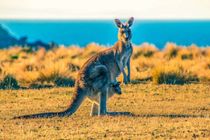Fun Kangaroo Facts For Kids
A uniquely large mammal found largely in Australia, kangaroos are very important to Australian culture, and they even feature on the Australian coat of arms. Technically, what we refer to as kangaroos are the majority of macropods, i.e.
the family Macropodidae. Known specifically for their large and powerful hind legs on which they hop around in the woods and scrublands of Australia, they are visually unique.
There are about 50 kangaroo species in the family Macropodidae. The diverse group of macropods has remarkable adaptability, and they have evolved to occupy not only terrestrial living spaces but also up in the woods and down below the ground.
In general, kangaroos could be classified into three distinct types.
A tree kangaroo (genus Dendrolagus), as you can guess, is suited to an arboreal lifestyle. In fact, they are much more agile on the trees than they are on the ground.
Outside of Queensland, Australia, different tree kangaroo species can be found deep inside the forests of New Guinea.
The tiny cousins of kangaroos, wallabies, are glossier and more agile. They are all even smaller and lighter than wallaroos (macropods that are on average much smaller than the common genus Macropus) and other than Australia and New Guinea, the wallabies are also to be found in Hawaii, New Zealand, and the UK.
The third type is what we know and imagine of the common kangaroo. The red kangaroo (Osphranter rufus), is the most muscular kangaroo found in the more arid parts of Australia.
The far more common species is the eastern gray kangaroo (Macropus giganteus) who live in the greener eastern side of Australia. A smaller type, the western gray kangaroo (Macropus fuliginosus) lives in south-eastern Australia and the Murray-Darling Basin.
Another interesting species is the antilopine kangaroo (Osphranter antilopinus), who get their name from their antelope-like color and texture of fur. While technically a wallaby, the antilopine kangaroo is much more similar to the larger red and gray kangaroos in behavior and habitat of choice.
Intrigued? Keep reading! For more facts, check out the marsupial and fennec fox.
Kangaroo Interesting Facts
What type of animal is a kangaroo?
The kangaroo is a large marsupial. That means that the females possess a marsupium, i.e. a pouch to carry the joeys in.
What class of animal does a kangaroo belong to?
All kangaroos are mammals.
How many kangaroos are there in the world?
The number of kangaroos is abundant enough that the Australian government allows limited kangaroo harvest - but only for the most populous six species. All in all, there are about 40 million kangaroos in the world.
Where does a kangaroo live?
Different breeds of kangaroos and wallaroos live out in the open plains and woods - grasslands, savannas, and scrublands - with the exception of tree kangaroos who mostly reside in dense rainforests.
What is a kangaroo's habitat?
The antilopine kangaroo lives in the monsoonal eucalyptus woodlands in the far northern region of Australia. Red kangaroos inhabit flat arid badlands all over central Australia.
Western grays and eastern grays live in the western and eastern regions of Australia, both in denser grazelands and scrublands. Outside of Australia, kangaroos and wallabies are also found in New Guinea, Hawaii, and even the UK.
Who do kangaroos live with?
Kangaroos live in groups, and a group of kangaroos is called a mob (alternate terms are 'troop' and 'court'). That being said, they are not really organized if you compare it to a group of penguins.
Every kangaroo within the mob moves at liberty. They are indeed very social animals.
They can thump their tails and/or feet on the ground to alert the rest of looming threats. In the case of such threats, the members of a mob all disperse and hop off in different directions. Kangaroos can build social cohesion reinforced through nose-touching and sniffing each other.
In a mob, there is always a lead boomer - the patriarch, if you will - that has exclusive access to the females for mating. It is common for males to fight and box each other over this access.
How long does a kangaroo live?
The lifespan of an average western gray kangaroo can go up to 10 years, and it is roughly the same with eastern grays. In captivity, an eastern gray can live up to 20 years.
Red kangaroos live much longer, about 22 years in the wild. In captivity, they only live half as long. Tree kangaroos are estimated to live longer than the western grays, and the oldest one in captivity lived to be 27.
How do they reproduce?
Kangaroos reproduce in the same way as opossums do. An offspring is born only after about a month of gestation period, and then its mother deposits it into her pouch where it nourishes and develops.
Annually, the females give birth once on average. They also have the ability to keep reserve embryos frozen in a dormant stage until the offspring is out of the pouch.
This is known as embryonic diapause. The mother also develops two kinds of milk, one for the young in the pouch, and another for more matured joeys that are out of the pouch.
What is their conservation status?
Most kangaroos are abundant across Australia, and kangaroo harvest is legal for some species. They are threatened by human activity and calamities like wildfire, but the lack of natural predators means that the 'big breeds' of macropods - the red kangaroos, the western gray, and the eastern gray, are put under Least Concern on the IUCN list.
Tree kangaroos, however, are a different tale.
Most of them are currently either Vulnerable (e.g. Dendrolagus dorianus) or Endangered (e.g. Dendrolagus matschiei).
Kangaroo Fun Facts
What do kangaroos look like?
There is nothing quite like a kangaroo in appearance. The largest marsupial known to man, red kangaroos support their body weight with a muscular tail that is almost as big as their upstanding height, and two powerful hind legs.
In fact, Macropodidae means exactly that - big feet. Their fur is generally red, gray, or a mishmash between gray and patches of blue, mostly seen in females. Two symmetrical white stripes run from their snout to the back of their ears.

How cute are they?
Joeys can look quite cute with their doe eyes as they peek occasionally from the mother's pouch. Their hops can often look sweet too. Behaviorally, though, they can often be quite aggressive.
How do they communicate?
Kangaroos can communicate vocally. In a more intimate context, they make soft clicking sounds, often in a row.
This is the most common form of communication between a mother kangaroo and her joey kangaroo. Other than these, they also have a vocal way to express aggression in the form of growls and barks, like the cough-like growling seen between males fighting over access to a female.
Although the vocal communication only takes second place after their other instrument of communication: their strong hind legs.
Kangaroos communicate by stomping their feet (or thumping their tail) on the ground. The stomps are very effective in particular to alert the rest of the kangaroo mob about looming danger.
How big is a kangaroo?
As the family macropod is a diverse one, kangaroos come in many sizes. Take for instance the dwarf wallaby.
It is likely the smallest of the lot and is less than 1.5 ft if you measure its length from the nose to the tip of its tail. Standing upright next to you, a wallaby would probably reach only up to your knee.
On the other hand, the red kangaroo is the biggest marsupial in the world, with a whopping 8 ft of length from head to tail on average. Standing upright, they would easily match humans in height.
How high can a kangaroo jump?
Thanks to the stretchy tendons in their powerful hind legs, kangaroos can jump quite high. In fact, they are probably the only mammal whose locomotion is solely based on hopping.
A red kangaroo regularly hops about 5 ft (1.5m) in an average leap, and this can go up to 25 ft. Vertically, they can jump up to 6 ft high, so they can technically jump more than their upstanding height. This is for adult red kangaroos, though. Joeys and smaller kangaroo variants like wallabies cannot jump nearly as high.
How much does a kangaroo weigh?
Needless to say, different kangaroo species belong to different weight groups. A tiny adult wallaby can actually weigh as little as 4 kg, while the largest adult red kangaroo male can go up to 90 kg.
In the case of tree kangaroos, their lighter weight (6-7 kg) helps them traverse over treetops. Larger roos like the western gray kangaroo are quite heavy, but their hind legs are still strong enough to enable regular hopping.
What are their male and female names of the species?
The male kangaroos are called boomers or bucks. Female kangaroos, on the other hand, are called flyers and does. Female kangaroos are actually more agile than males, so considering the fact that they go from point A to point B at the speed of a motorized vehicle by hopping, the name flyers is pretty apt.
What would you call a baby kangaroo?
Baby kangaroos are called joeys. As the trademark of marsupials, joey kangaroos belong in their mother's pouch. Joeys grow up fast, though. The average western gray female kangaroo takes about 14-20 months to fully mature into an adult. For the male kangaroos, that period is about two to four years.
What do they eat?
Kangaroos are herbivores and eat grass and shrubs. They also digest the vegetation in two phases.
First, they consume and regurgitate it, and then they chomp down on it again with their molar teeth. The molars erode due to wear and tear, fall off, and are replaced. Kangaroos can also stay without water for long periods of time, nourished just by the hydration within the vegetation they chew.
Are they dangerous?
Kangaroos are usually quiet grazers, if not completely docile. But make no mistake, they are highly powerful and can dispatch threats with brute force if compelled to.
Kangaroos can box well with their agile forearms. They can also use the forearm to grip a target, and disembowel them with swift kicks from their clawed feet - a technique they can use on predators, each other, or even humans.
Would they make a good pet?
Kangaroo care is quite difficult and it would not be a recommended choice for a pet. Macropods easily succumb to stress-related disorders in captivity. Furthermore, they can be quite dangerous when they are aggressive.
Did you know...
Kangaroo meat is actually quite popular in Australia! The kangaroo population is large enough for a legalized annual kangaroo harvest season. In fact, their population can grow so rapidly while kept unchecked that they are a more sustainable source of meat than traditional cattle.
In Western Australia, there is a genus of perennial plants with tubular flowers called 'kangaroo paw'.
Kangaroo claws are sharp enough to slice skin open at ease.
A female red kangaroo is actually a blue kangaroo, with a uniquely blue-hued coat of fur.
Here are some kangaroo pouch facts. They can get quite smelly, as the joey poops and pees inside it.
The mother often has to lick it clean. The inside of the pouch is quite sticky, too. It's not all cute, though, as the mother is known to throw the baby out of the pouch on occasion - sometimes even to a predator.
What sound does a kangaroo make?
Kangaroos can make soft clucking noises, and also growl and bark. They are at their loudest when they stomp their feet on the ground. Overall, a mob of kangaroos is usually a very loud bunch when they are not sleeping.
Do kangaroos fart?
Like most mammal herbivores, kangaroos do fart. However, their flatulence is not nearly as methane-heavy as cows.
Here at Kidadl, we have carefully created lots of interesting family-friendly animal facts for everyone to discover! Learn more about some other mammals including anteater, or bandicoot.
You can even occupy yourself at home by drawing one on our kangaroo coloring pages.
We Want Your Photos!
More for You
See All
Bachelor of Arts specializing in Journalism and Mass Communication, Postgraduate Diploma in Sports Management

Moumita DuttaBachelor of Arts specializing in Journalism and Mass Communication, Postgraduate Diploma in Sports Management
A content writer and editor with a passion for sports, Moumita has honed her skills in producing compelling match reports and stories about sporting heroes. She holds a degree in Journalism and Mass Communication from the Indian Institute of Social Welfare and Business Management, Calcutta University, alongside a postgraduate diploma in Sports Management.
Disclaimer
1) Kidadl is independent and to make our service free to you the reader we are supported by advertising. We hope you love our recommendations for products and services! What we suggest is selected independently by the Kidadl team. If you purchase using the Buy Now button we may earn a small commission. This does not influence our choices. Prices are correct and items are available at the time the article was published but we cannot guarantee that on the time of reading. Please note that Kidadl is a participant in the Amazon Services LLC Associates Program, an affiliate advertising program designed to provide a means for sites to earn advertising fees by advertising and linking to Amazon. We also link to other websites, but are not responsible for their content.
2) At Kidadl, we strive to recommend the very best activities and events. We will always aim to give you accurate information at the date of publication - however, information does change, so it’s important you do your own research, double-check and make the decision that is right for your family. We recognise that not all activities and ideas are appropriate for all children and families or in all circumstances. Our recommended activities are based on age but these are a guide. We recommend that these ideas are used as inspiration, that ideas are undertaken with appropriate adult supervision, and that each adult uses their own discretion and knowledge of their children to consider the safety and suitability. Kidadl cannot accept liability for the execution of these ideas, and parental supervision is advised at all times, as safety is paramount. Anyone using the information provided by Kidadl does so at their own risk and we can not accept liability if things go wrong.
3) Because we are an educational resource, we have quotes and facts about a range of historical and modern figures. We do not endorse the actions of or rhetoric of all the people included in these collections, but we think they are important for growing minds to learn about under the guidance of parents or guardians.







